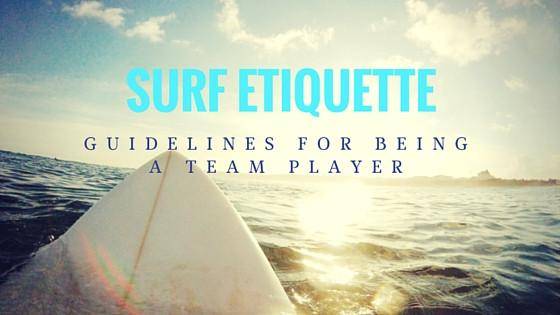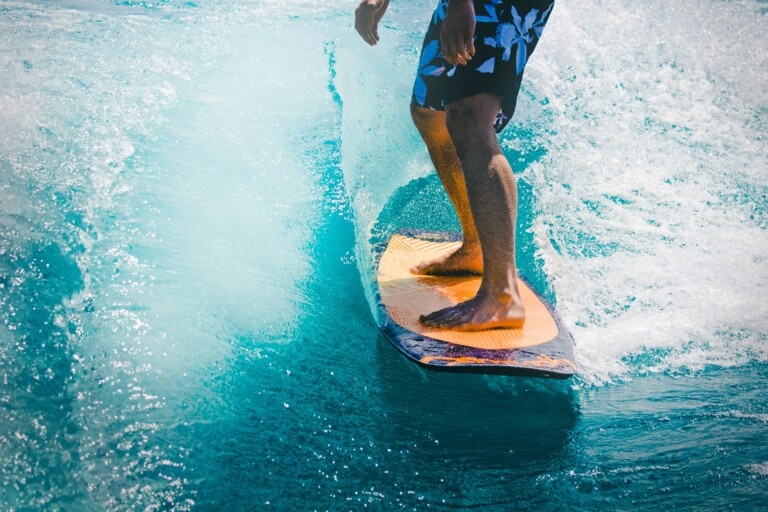PADDLING OUT
- Choose Wisely
Pick surf spots that suit your ability and try not to get in over your head. If you think it looks too big from shore, it’ll look even bigger from the water. Know your capabilities and err on the side of safety.
Make Some Room
Try not to paddle out close to others. You never know when a big wave will appear and send people and boards flying. Give yourself room and try not to paddle out right behind another surfer.
- Go Around
Whenever possible paddle around the lineup, not through it. At most surf spots, there is a channel or section of beach with fewer waves. Take advantage of those areas to paddle out; it’s safer for you and the other surfers around you. But, if you’re at a beach where there’s no discernable spot to paddle out, see below….
- Stay Out of the Way
The paddling surfer yields to the surfer riding ahead of them. If you get caught inside the breaking waves, let anyone surfing ahead of you pass and then continue to paddle out. Sometimes this means you may have to tackle some whitewash, but that’s just the way it goes. Also, there will inevitably be times when you end up in a wrong spot and find yourself directly in the path of a riding surfer. In these cases, do your best to paddle fast as you can over the shoulder and out of the surfer’s way.
In short, while you’re paddling out, do you best to stay out of everyone’s way. It’s the courteous thing to do, and it also helps avoid in-water collisions.
RIDING
- Don’t Drop In
Dropping in is when you start riding a wave that someone else was riding first. Keep reading below for more on who has the right of way on waves, but the best thing you can do when paddling for a wave is to stay aware and know who is around you.
- Closest to the Peak and First to Their Feet
The surfer closest to the peak of the wave has the right of way. Look left and right when you’re taking off on a wave and if you see someone closer to where the wave is breaking who is angling towards you, back off and get out of their way. Sometimes you’ll also hear that the surfer who is first to their feet gets the wave, but this is thought of as a first rule. At breaks where there’s both long boarders and short boarders, long boarders often get to their feet first due to the buoyancy of their boards, so the closer to the peak rule was derived to make sure everyone got a turn, even short boarders who make take off deeper on the wave.
- Communicate
When a wave breaks both left and right, two surfers can happily ride the same wave, just make sure to communicate by announcing if you’re going right or left, even if you think it’s obvious. A little communication in the water can do a lot to keep everyone safe and having fun.
- Share
Just because you can catch every wave, doesn’t mean you should. If you’re on a large foam board or longboard that catches waves easily, it doesn’t mean you always get to take the wave from the shortboard next to you that’s looking to practice turns and airs. Always keep in mind that the ocean is for everyone and act accordingly.
- Don’t Snake
There’s no faster way to lose respect in the lineup than to snake people’s waves. You snake someone when you knowingly paddle around a surfer that’s going for a wave to get the “closer to the peak” right of way. It’s not cool or cute, so don’t do it.
- Just Good Advice
Always Hold onto Your Board!
Surfboards are big, heavy and have pointy fins, which is why you usually don’t want them flying around uncontrollably. And that’s what happens when you ditch your board. You can’t always count on your leash to keep your board tethered to you, so do you best to keep your hands on it at all times. There will be instances when you get wrecked and lose your board, it’s okay, it happens to even the best surfers. Just do your best to regain control as soon as you can.
Respect
If you give respect, you will get respect. It’s that simple, and it works in any language or country.
SPEAKING OF RESPECT…
Comply with the beach and the surrounding areas, don’t trespass, speed through neighborhoods, park in places you shouldn’t and leave trash on the beach or in the water. In fact, a great rule of thumb is if you see a piece of trash, pick it up and throw it away, even if it’s not yours.
- Apologize
If you’re new to surfing, this list can seem daunting. But most of the rules are common sense and if you mess up, just apologize. Recognizing your error and offering a sincere sorry can go a long way towards diffusing any tension in the water and earning respect from your fellow surfers.
Study this list and you can paddle out with confidence, knowing that with a few rules surfers of all abilities can safely share the same waves. We’ll see ya in the water!
FYI, this site had some great little drawings of these concepts:
















